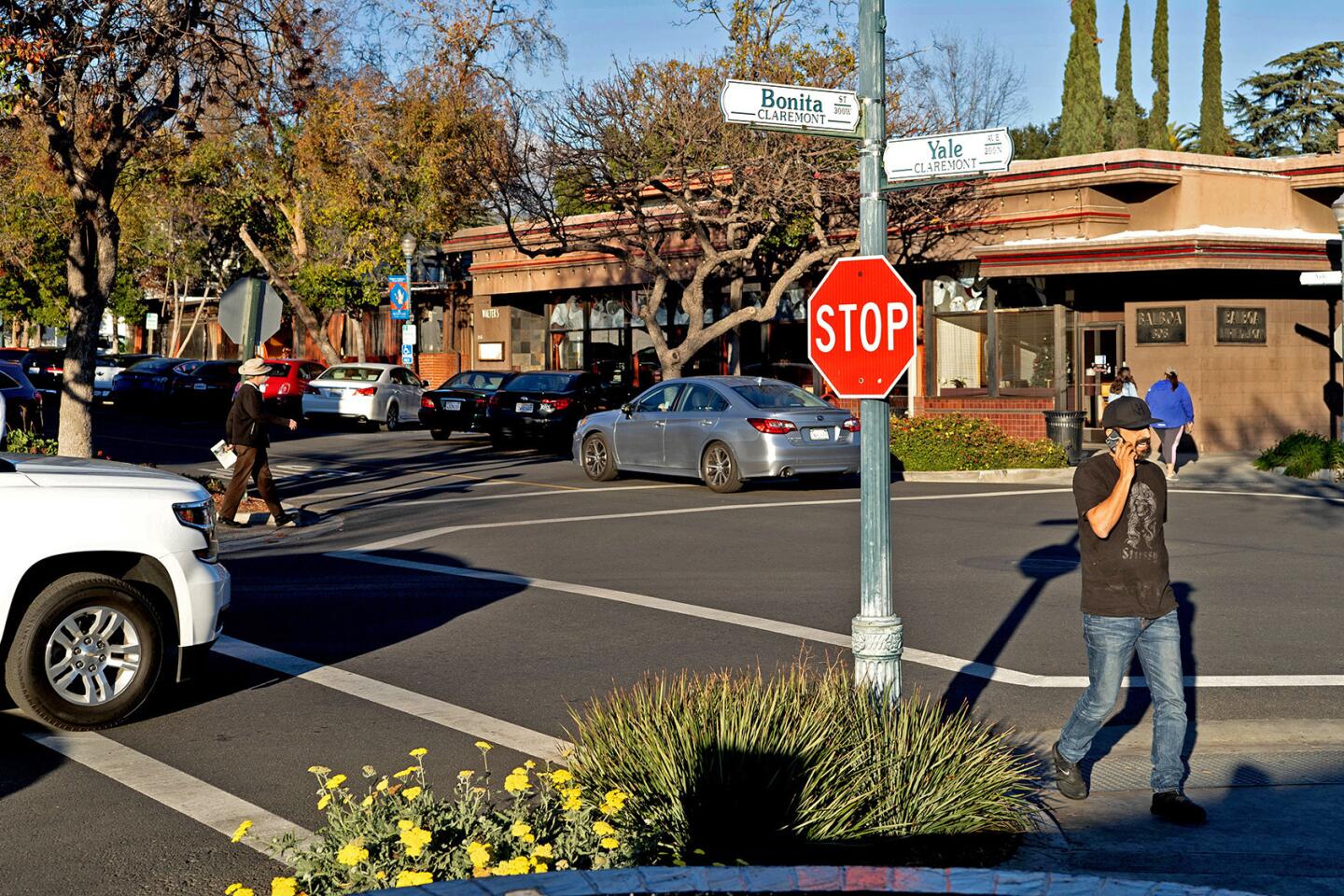Neighborhood Spotlight: Claremont owns its lettered and leafy college-town vibe
- Share via
When the Santa Fe Railroad pushed from San Bernardino to Los Angeles in 1887, Claremont was one of several communities founded along the route, ready to embrace the inevitable population boom.
But the people never came, and a year later the grand hotel and neighboring lots lay empty and seemingly destined for oblivion — until Pomona College decamped from its namesake city next door and took over the properties, steering Claremont to become the genteel college town it remains to this day.
The area that now comprises Claremont was first home to Serrano Indians, living in a village on a mesa near the future, aptly named Indian Hill Boulevard. Later the region was under the control of Mission San Gabriel, which the Spanish built in 1771. Then it was part of the Rancho San Jose, deeded by the Mexican government in 1837 to Ricardo Vejar and Ygnacio Palomares, a future mayor of Los Angeles.
For decades, the region was sparsely populated and home to cattle ranches, beekeepers and deciduous fruit groves. Then came the railroad.
Claremont was one of 30 communities mapped out along the rail route from San Bernardino, the culmination of Santa Fe’s progress from Chicago to L.A. Advertisements from the developer, the Pacific Land and Improvement Co., trumpeted the site’s clear mountain air and water, but a 1920 history of the Pomona Valley suggested the town name came from Claremont, N.H., hometown of one of the Pacific Land stockholders.
After an initial speculative frenzy, the real estate market collapsed, and only a few homes were ever even occupied. At the same time, local leaders of the Congregational Church wanted to create “a college of the New England type” in Pomona but couldn’t raise money for buildings.
After a mutually advantageous agreement, the already named Pomona College moved into the vacant hotel and other buildings in 1888.
By the early 1920s, Pomona College was flourishing and considering expansion, but then-President James Blaisdell instead favored a decentralized system, like that of Oxford and Cambridge — several small complementary colleges of different specialties.
With funding from newspaperwoman and philanthropist Ellen Browning Scripps, Scripps College for women opened in 1926. Claremont College (later Claremont-McKenna) opened in 1946, with the goal of training future leaders through a liberal arts curriculum. Harvey Mudd College opened in 1957 as a liberal arts school focusing on STEM fields. With Pitzer College (1963), Claremont Graduate University (1925) and Keck Graduate Institute (1997), the Claremont Colleges now consist of five undergraduate colleges and two graduate schools, all within one square mile. In addition to being the heart of the city, they are, by a factor of four, its biggest employer.
Claremont had also been an important center of citrus — growers there formed one of the first cooperatives in California, joining forces under the Claremont California Fruit Growers’ Assn. to pack, ship and promote their product. In 1893, they even scored a marketing coup, famously shipping a crate of Indian Hill oranges to Queen Victoria.
But, like so many places in Southern California, the groves that once dominated the landscape gave way to neighborhoods in the housing boom that followed World War II.
The opening of the San Bernardino Freeway in 1954 helped transition Claremont from academic enclave to bedroom community. Now a city of about 37,000, Claremont was named Sunset magazine’s “best suburb in the West” in 2016. Sunset cited its East Coast college town vibe and said it “blends worldly sophistication with small-town appeal.”
Neighborhood highlights
Lettered and leafy: Known as the “City of Trees and PhDs,” Claremont benefits from the foresight of city pioneers more than a century ago who planted trees and established parks throughout the community. The city is also home to the Rancho Santa Ana Botanic Gardens, which opened in 1927 and specializes in California native plants. And the verdant, city-run Claremont Hills Wilderness Park abuts the San Gabriel Mountains National Monument, 346,000 acres of additional forest lands.
Reuse and revival: The Village, the city’s downtown district, includes scores of cafes, boutiques and galleries. One landmark is the Claremont Packing House, a once decrepit former citrus warehouse, now renovated with shops, restaurants and live/work lofts.
Neighborhood challenges
Highbrow and high-priced: The erudite atmosphere comes at a cost, with average home prices significantly higher than in neighboring communities, such as Pomona and Upland. In addition, open space is a premium, so any new construction would likely have to be in the foothills, where land is even more expensive than elsewhere in the city.
Expert insight
Because of the Claremont Colleges’ spread across the city, broker Lilyvette Rodriguez said the community feels like a college town: a hip downtown area surrounded by ranch- and Craftsman-style homes.
She calls the market “entry-level luxury,” with most houses ranging from $550,000 to $750,000. The foothills hold the pricier properties, where baseball players and other big-spending residents pay more than $1 million for a bigger home with better views.
“You feel the hominess as soon as you drive into the city,” Rodriguez said. “It’s similar to neighbors like Pomona and Upland, but the close-knit community feels a bit more pronounced.”
Market snapshot
In the 91711 ZIP Code, based on 22 sales, the median sales price for single-family homes in November was $703,000, down 5.4% year over year, according to CoreLogic.
Report card
Ten public schools in the Claremont boundaries scored above 800 in the 2013 Academic Performance Index, and two scored over 900. The highest scorer was Condit Elementary at 930, followed by Chaparral Elementary at 922.
El Roble Intermediate scored 861. Claremont High, the city’s largest high school, scored 839.
Times staff writer Jack Flemming contributed to this report.
More to Read
Sign up for Essential California
The most important California stories and recommendations in your inbox every morning.
You may occasionally receive promotional content from the Los Angeles Times.











